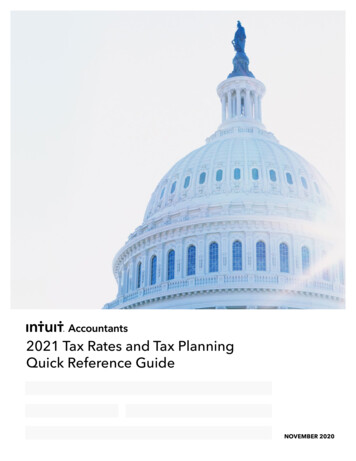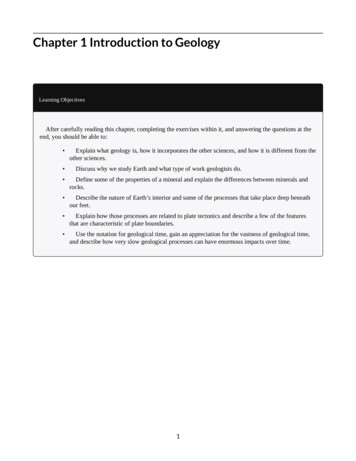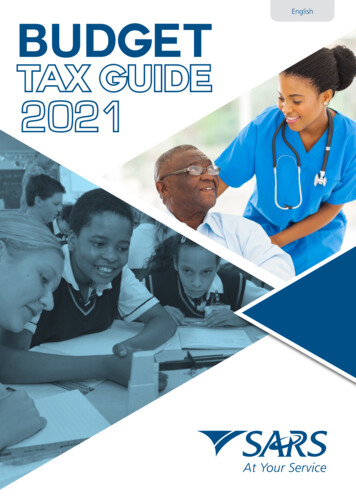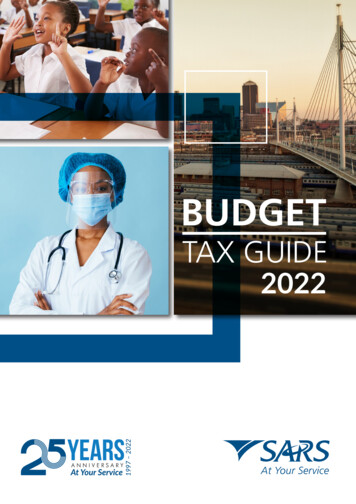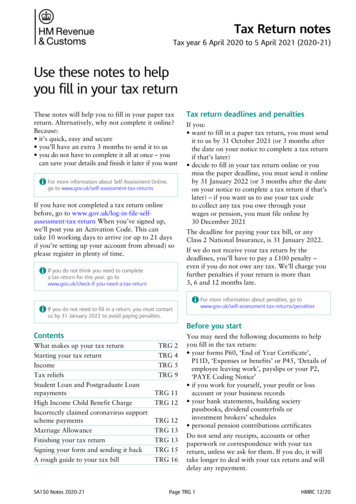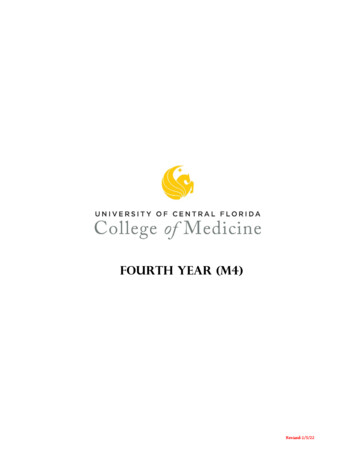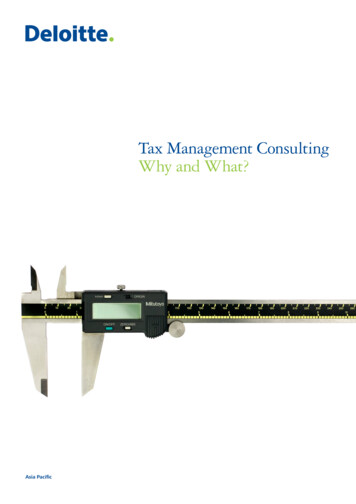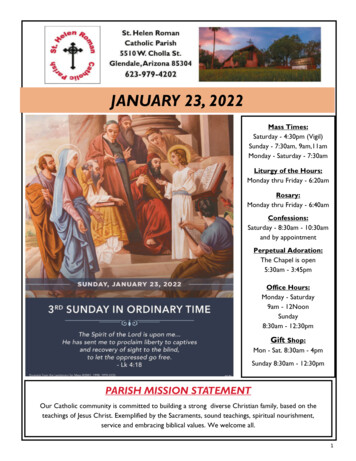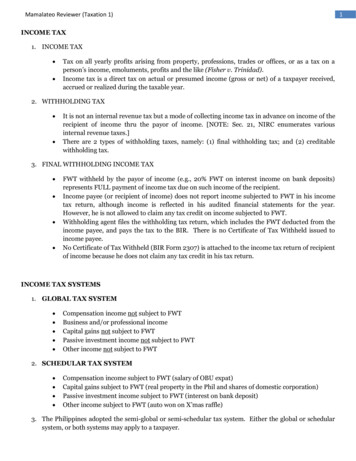
Transcription
Tax Guide 2022 – 2023
ForewordGlacier by Sanlam recognises the importance of tax planning as partof one’s overall financial planning. We’re pleased to sponsor theMoneyMarketing tax guide for the 2022 – 2023 tax year. We trustthat the guide will prove invaluable in assisting you with completingtax returns, reviewing portfolios, or in solving any tax-related queriesyou may have.An investment with moreadvantages is hard tocome by.Endowments are often overlooked, but theyoffer so much for the investor.Endowments offer insolvency protection, estate planningbenefits, and they’re tax efficient too. There are also nolimitations on the maximum level of equity exposure.Visit www.glacierinsights.co.za for more information onGlacier’s wide range of solutions.Glacier provides access to a number of tax-efficient, local andinternational investment solutions to cater for a diverse set of needs –whether that be saving for retirement or for a more shorter-term goal.Investors can select from a wide range of collective investments, aswell as wrap funds and listed share portfolios via our platform. Weoffer discretionary fund management and investment consultingservices through Glacier Invest, giving financial intermediaries accessto leading investment solutions and strategies for their clients.In addition to our platform solutions, Glacier also offers a rangeof investment solutions including guarantees, and traditional lifeinvestments through our partnership with Sanlam Life, for thoseseeking more certainty in uncertain markets. Many investors maybenefit from using a market-linked investment in combination with aguaranteed product.We benchmark ourselves against international standards and partnerwith leading local and global providers. We understand that when itcomes to financial services, you expect nothing less than the best.We’re committed to providing superior service combinedwith international best practices. Please visit our website,www.glacierinsights.co.za, for more information. Alternatively, ifyou have any queries regarding the above solutions, you may contactour Communication Centre on 021 917-9002 / 0860 452 364 or021 917-9000 / 0860 452 237.Glacier Financial Solutions (Pty) Ltd andSanlam Life Insurance Ltd are licensedfinancial services providers.1
INDEXAdaptability is our longevityPKF is one of the largest mid-tier accounting networks in the worldand in South Africa. Our South African network is made up of 9independent firms in 6 provinces, over 70 Partners and Directorsand over 900 staff members. We provide high-quality audit,accounting, tax and business advisory solutions.Our size and structure give you direct access to real experience,fast. Our partners are accessible to you on each engagement,and are unwavering in their commitment to providestraightforward advice.CONTACT USonline@pkfsa.co.za I www.pkf.co.za/locations/right peopleright sizeright solutionsCopyright 2022 PKF South Africa Inc. PKF South Africa Inc. member of PKF InternationalPKF South Africa Inc. is a member firm of the PKF International Limited family of legally independentfirms and does not accept any responsibility or liability for the actions or inactions of any individualmember or correspondent firm or firms.2Administrative PenaltiesArbitration AwardsAssessed Losses Ring-FencedBody CorporatesBond/Instalment RepaymentsBroad-Based Employee EquityBudget ProposalsBursaries and ScholarshipsCapital Gains TaxCapital Incentive AllowancesCommon Reporting StandardCountry-by-Country ReportingDebt Concession or CompromiseDeductions - DonationsDeductions - EmployeesDeductions - RetirementDeductions - RoyaltiesDeductions - Travel ExpensesDeemed Capital - Disposal of SharesDeemed EmployeesDirectors FeesDispute ResolutionDividend StrippingDividends TaxDonations TaxDouble Taxation AgreementsDoubtful Debt AllowanceEffective Tax RateEmployment Tax IncentiveEstate DutyExchange Control RegulationsExecutor’s RemunerationExemptions - IndividualsFarming IncomeForeign Companies/Branch TaxForeign Employment IncomeFringe BenefitsHeadquarter CompanyHome Office DeductionHotel AllowancesIndustrial Policy ProjectsInterest Rates - ChangesInvoluntary DisposalsIRP5 CodesLearnership AllowancesLimitation of Interest DeductionLoans to Trusts - Section 7CMarried in Community of PropertyMedical Aid Tax CreditsMedical Expense Tax CreditsNon-ResidentsPatent and Intellectual 23624Penalties and InterestPre-Paid ExpenditurePre-Production InterestPre-Trading ExpenditurePrime Overdraft RatesProvisional TaxPublic Benefit OrganisationsRecreational ClubsReinvestment ReliefRelocation of an EmployeeReportable ArrangementsResearch and DevelopmentResidence Based TaxationResidential Building AllowancesRestraint of TradeRetention of Documents/RecordsRetirement Lump Sum BenefitsSecondary Tax on CompaniesSecurities Transfer TaxSkills Development LevySmall Business CorporationsSpecial Economic ZonesStrategic AllowancesSubsistence AllowancesSuspension of PaymentTax ClearanceTax Free InvestmentsTax Rates - CompaniesTax Rates - IndividualsTax Rates - TrustsTax RebatesTax ThresholdsTransfer DutyTransfer PricingTravel AllowancesTrust Distributions - Local TrustTrust Distributions - Foreign TrustTurnover Tax - Micro-BusinessesUnderstatement PenaltiesUnquantified ProceedsValue-Added TaxVariable RemunerationVAT Claw-Back for DevelopersVAT Relief - Inter-GroupVenture Capital InvestmentsVoluntary DisclosureWear and Tear AllowancesWithholding Taxes SummaryWithdrawal Lump Sum BenefitsWithholding Tax on InterestWithholding Tax on 3637
BUDGET PROPOSALS12345Company Tax RatesFor years of assessment ending on or after 31 March 2023, the companytax rate will be reduced to 27% together with the implementation of thelimitation of assessed losses and interest deductions in relation to certainforeign loans.Research and DevelopmentThe incentive will be extended in its current form until 31 December 2023.Provisional Tax and Tax ClearancesThere will be a review of these systems.Employment Tax IncentiveThe employment tax incentive is expanded to encourage businessesto increase youth employment. Due to the abuse of the incentive,understatement penalties will be imposed on improper claims.Disclosure of WealthIt is proposed that all provisional taxpayers with assets aboveR50 million will be required to declare specified assets and liabilities atmarket values in their 2023 tax returns.HOME OFFICE DEDUCTIONThe requirements for the deduction of home office costs are onerous andmust be based on the ratio of the actual floor area of the office to the actualfloor area of the home.The deduction will only be allowed where the home office is regularly andsolely used for the purpose of the taxpayer’s trade and has been specificallyequipped for such purpose.Where the taxpayer derives income mainly from commission, the duties mustbe mainly performed outside an office provided by the employer.Where the taxpayer is an employee, the duties must be performed at thehome office for more than 50% of the time.The claiming of the deduction will impact the primary residence exemptionfor capital gains tax on the disposal of the property.This booklet is published by PKF Publishers (Pty) Ltd for and on behalf ofchartered accountants& business advisers All information contained herein is believed to be correct at the time of publication,23 February 2022. The contents should not be used as a basis for action withoutfurther professional advice.While utmost care has been taken in the compilation of this publication no responsibilitywill be accepted for any inaccuracies, errors or omissions.The information incorporates commentary from the budget speech but the legislationfinally enacted may differ.Changes in rates of tax announced in the budget speech for the 2023 tax year becomeeffective only once the legislation is enacted by Parliament.Copyright subsists in this work. No part of this work may be reproduced in any form orby any means without the publisher’s written permission.4LOANS TO TRUSTS SECTION 7CAs from 1 March 2017, interest-free or low interest loans to a trust by aconnected natural person or by a company connected to that natural persongive rise to a deemed donation. The donation is the difference between theinterest rate charged and the official interest rate applied to the loan amount.This deemed donation applies to new and existing loans, excluding: Loans to certain vesting and certain share incentive trusts Loans to special trusts created solely for the benefit of a personwith a disability Loans to approved public benefit organisations Loans funding the primary residence of that person or their spouse Loans to small business funding entities Loans where transfer pricing rules apply Loans provided in terms of a Sharia compliant financing arrangement Loans subject to Dividends Tax Unpaid beneficiary distributions, subject to certain provisions whichmay include a requirement that:- the trust deed stipulates (or the trustees have the sole discretion todetermine) the time and extent of payment of such vested amount- the beneficiary has not entered into an agreement with the trusteeto retain such amount in the trust.The interest foregone is treated as an ongoing annual donation by thatperson as at the end of the tax year. Donations Tax will be payable at the endof March of each year. The annual Donations Tax exemption of R100 000may be claimed if not already utilised.As from 19 July 2017, loans provided by natural persons to companiesheld by trusts or loans ceded to connected natural persons such as trustbeneficiaries are included.As from 1 January 2021, certain preference shares issued to a connectednatural person are treated as deemed loans.Example: An interest free loan of R2,5 million provided to a trust on 1 March2021 and the loan remained constant during the year, the calculation is:RLoanInterest 1 March 2021 to 30 November 2021 (275/365 days) at 4,50%Interest 1 December 2021 to 31 January 2022 (62/365 days) at 4,75%Interest 1 February 2022 to 28 February 2022 (28/365 days) at 5,00%Deemed donationLess annual exemptionNet deemed donation at 28 February 2022Donations Tax at 20% (due 31 March 2022)2 500 000,0084 760,2720 171,239 589,04114 520,54100 000,0014 520,542 904,11FOREIGN EMPLOYMENT INCOMEAs from 1 March 2020, foreign employment income not exceeding R1,25 millionis exempt, provided the person spends more than 183 days (2020 and 2021tax years: 117 days), of which at least 60 days is continuous, outside SouthAfrica in any 12 month period commencing or ending during that tax year.Prior to 1 March 2020, foreign employment income was fully exempt providedthe same days requirement was met.5
TAX RATESTAX RATESCOMPANIESIncome TaxTaxable incomeFor years of assessment ending during the following periods:1 April 1993 - 31 March 19941 April 1994 - 31 March 19991 April 1999 - 31 March 20051 April 2005 - 31 March 20081 April 2008 - 28 February 202340%35%30%29%28%SA Income - Foreign Company/Branch Tax40%35%34%33%28%Secondary Tax on CompaniesDividend declared between 22 June 1994 and 13 March 1996Dividend declared between 14 March 1996 and 30 September 2007Dividend declared between 1 October 2007 and 31 March 2012Dividend paid or becomes due and payable from 1 April 2012Dividend paid or becomes due and payable from 22 February 2017EFFECTIVE TAX RATE2014to2016Available for distributionLess: DividendRetainedTotal taxNormal taxDividends TaxEffective rate25%12,5%10%Rates of tax18% of each R1R 38 916 26% of the amount overR 70 532 31% of the amount overR110 739 36% of the amount overR163 335 39% of the amount overR229 089 41% of the amount overR587 593 45% of the amount overR 216 200R 337 800R 467 500R 613 600R 782 200R1 656 600INDIVIDUALS - 2023Taxable incomeR0 - R 226 000R 226 001 - R 353 100R 353 101 - R 488 700R 488 701 - R 641 400R 641 401 - R 817 600R 817 601 - R1 731 600R1 731 601 Rates of tax18% of each R1R 40 680 26% of the amount overR 73 726 31% of the amount overR115 762 36% of the amount overR170 734 39% of the amount overR239 452 41% of the amount overR614 192 45% of the amount overR 226 000R 353 100R 488 700R 641 400R 817 600R1 731 600TAX THRESHOLDSTaxable incomeDividends TaxTaxable incomeLess: Normal taxR0 - R 216 200R 216 201 - R 337 800R 337 801 - R 467 500R 467 501 - R 613 600R 613 601 - R 782 200R 782 201 - R1 656 600R1 656 601 TAX RATESFor years of assessment ending during the following periods:1 April 1996 - 31 March 19991 April 1999 - 31 March 20051 April 2005 - 31 March 20081 April 2008 - 31 March 20121 April 2012 - 28 February 2023INDIVIDUALS - 202215%20%Tax year201720172018Prior toFromto22 Feb 2017 22 Feb 2017 28 Feb 28,0010,80Assumes all profits are declared as a dividend.628,0014,4028,0014,40Persons under 65Persons 65 and under 75Persons 75 and over2022R 87 300R135 150R151 1002023R 91 250R141 250R157 9002022R15 714R24 327R27 1982023R16 425R25 425R28 422TAX REBATESAmounts deductible from the tax payablePersons under 65Persons 65 and under 75Persons 75 and overMEDICAL AID TAX CREDITSMonthly amounts deductible from tax payableMain memberMain member with one dependantMain member with two dependants2022R332R664R8882023R347R694R928Each additional dependant qualifies for a credit of R234 (2022 : R224)per month.7
TAX RATES TRUSTSRate of taxAll taxable incomeSMALL BUSINESS CORPORATIONS201540%2016-201741%2018-202345%Special trusts are taxed at the rates applicable to individuals, but are notentitled to any rebate. The 40% inclusion rate for a taxable capital gainapplies to both types of special trusts.A special trust is one created: solely for the benefit of a person affected by a mental illness or seriousphysical disability which prevents that person from earning sufficientincome to maintain himself. Where the person for whose benefit the trustwas established dies prior to or on the last day of the year of assessmentthe trust will no longer be regarded as a special trust as a testamentary trust established solely for the benefit of minor childrenwho are alive and related to the deceased on the date of death. Wherethe youngest beneficiary turns 18 years of age (2013 : 21) prior to oron the last day of the year of assessment, the trust will no longer beregarded as a special trust.TURNOVER TAXMICRO-BUSINESSESYears of assessment ending between 1 March 2014 and 28 February 2015TurnoverR0 - R 150 000R150 001 - R 300 000R300 001 - R 500 000R500 001 - R 750 000R750 001 - R1 000 000Rates of taxNil1% of the amount over R 150 000R 1 500 2% of the amount over R 300 000R 5 500 4% of the amount over R 500 000R 15 500 6% of the amount over R 750 000Years of assessment ending between 1 March 2015 and 28 February 2023TurnoverR0 - R 335 000R335 001 - R 500 000R500 001 - R 750 000R750 001 - R1 000 000Rates of taxRRNil1% of the amount over R 335 0001 650 2% of the amount over R 500 0006 650 3% of the amount over R 750 000The simplified turnover-based tax system applies to qualifying soleproprietors, partnerships and incorporated businesses with a turnover of lessthan R1 million per year.The system is elective. For years of assessment commencing on or after1 March 2012, a micro-business can voluntarily exit the system at the end ofany year of assessment. However, once out of the system the taxpayer willnot be permitted to re-enter.Prior to this, a three year lock-in period existed for exit and re-entry into thesystem. Personal services rendered under employment-like conditions andcertain professional services are excluded from the system.For years of assessment commencing on or after 1 March 2018, transitionalmeasures were introduced to eliminate penalties when turnover exceedsR1 million and the micro-business is obliged to exit the system.8Years of assessment ending between 1 April 2021 and 31 March 2022Taxable incomeR0 - R 87 300R 87 301 - R365 000R365 001 - R550 000R550 001 Rates of taxNil7% of the amount over R 87 300R19 439 21% of the amount over R365 000R58 289 28% of the amount over R550 000Years of assessment ending between 1 April 2022 and 28 February 2023Taxable incomeR0 - R 91 250R 91 251 - R365 000R365 001 - R550 000R550 001 Rates of taxNil7% of the amount over R 91 250R19 163 21% of the amount over R365 000R58 013 28% of the amount over R550 000Qualifying requirements: All shareholders or members throughout the year of assessmentare natural persons who do not hold an interest in any other privatecompany, close corporation or co-operative other than those which:- are inactive and have assets with a market value less than R5 000; or- have taken steps to liquidate, wind-up or deregister (effective for yearsof assessment commencing on or after 1 January 2011). Gross income for the year of assessment does not exceed R20 million(2013 : R14 million). Not more than 20% of the gross income and all capital gains consistscollectively of investment income and income from the rendering ofa personal service.Investment income includes any annuity, interest, rental income fromimmovable property, royalty or any income of a similar nature, localdividends, foreign dividends (as from 1 April 2012) and any proceedsderived from investment or trading in financial instruments (includingfutures, options and other derivatives), marketable securities orimmovable property.Personal service includes any service in the field of accounting, actuarialscience, architecture, auctioneering, auditing, broadcasting, consulting,draughtsmanship, education, engineering, financial service broking,health, information technology, journalism, law, management, real estatebroking, research, sport, surveying, translation, valuation or veterinaryscience, performed personally by any person who holds an interest inthe company, co-operative or close corporation, except where suchsmall business corporation employs three or more unconnected full-timeemployees for core operations throughout the year of assessment. The company, close corporation or co-operative is not a personal serviceprovider or venture capital company.Where the business operates in a special economic zone the tax rate is thelower of 15% or the rate determined in accordance with the tables.Investment incentiveThe full cost of any asset used directly in a process of manufacture andbrought into use for the first time on or after 1 April 2001, may be deductedin the tax year in which the asset is brought into use. As from 1 April 2005,all other depreciable assets may be written off on a 50/30/20 basis.9
DIVIDENDS TAXPROVISIONAL TAXDividends Tax is applicable to all South African resident companies as wellas non-resident companies listed on the JSE. Dividends Tax is borne by theshareholder at a rate of 20% (prior to 22 February 2017 : 15%), subject toany reduction in terms of a double taxation agreement. Tax on dividends inspecie remains the liability of the company declaring the dividend.First Year of AssessmentSouth African resident companies, the Government, public benefitorganisations, certain exempt bodies, closure rehabilitation trusts, retirementfunds, shareholders in a registered micro-business (provided the dividenddoes not exceed R200 000 in the year of assessment), are exempt fromDividends Tax. The exemption also applies to dividends in specie.As from 1 April 2012, any dividend that was subject to STC is also exempt.A non-resident receiving a dividend from a non-resident company, which islisted on the JSE, is exempt from Dividends Tax.Second PaymentExemptions from Dividends TaxWithholding Tax ObligationsThe company declaring the dividend, other than dividends in specie, isrequired to withhold the Dividends Tax on payment. Liability for withholdingtax shifts if the dividend is paid to a regulated intermediary which includescentral securities depository participants, brokers, collective investmentschemes, approved transfer secretaries and linked investment serviceproviders.Dividends Tax can be eliminated or reduced upon the timely receipt of awritten declaration that the shareholder is either entitled to an exemption orto double taxation agreement relief and an undertaking that the shareholderwill inform the company should there be a change in circumstances.As from 1 July 2020, the written declaration and undertaking must berenewed every five years from the date of the original declaration.In the case of dividends in specie there is no withholding obligation, as thetax is the liability of the company declaring the dividend.Dividend DefinitionThe definition of a dividend includes all distributions to a shareholder, otherthan: a reduction of contributed tax capital an issue of capitalisation shares a general share buy-back by a JSE listed company an issue of shares as consideration for a share buy-back certain transfer pricing adjustmentsA distribution of contributed tax capital must be recorded in writing by thedirectors prior to making the distribution.Low Interest or Interest-Free LoansThere is a deemed dividend implication where a low interest or interest-freeloan or advance is made by a company to a resident natural person or trustconnected to the company or to a person (other than a company) who isconnected to such natural person or trust. The deemed dividend is thedifference between the interest rate charged and the official interest rateapplied to the loan amount and is treated as a cash dividend.Share Buy-backWhere an unlisted company buys back any portion of its own shares, theportion distributed from contributed tax capital will be subject to CapitalGains Tax and the portion distributed from reserves will be subject toDividends Tax.10Where a taxpayer has not been assessed previously, a reasonable estimate ofthe taxable income, and not merely a default of nil, must be made.First PaymentThe estimate of taxable income may not be less than the basic amount, unlesscircumstances justify a lower estimate.A two-tier system applies depending on the taxpayer’s taxable income: Actual taxable income of R1 million or lessTo avoid any penalty the basic amount must be used. If a lower estimate isused, this must be within 90% of the taxable income finally assessed. Actual taxable income exceeds R1 millionTo avoid any penalty the estimate must be within 80% of the taxableincome, excluding retirement fund lump sums, finally assessed.If the above requirements are not met, a penalty of 20% is levied on thedifference between the estimated tax and 90% of the actual tax (if thetaxable income is R1 million or less), or 80% of the actual tax (if the taxableincome exceeds R1 million), less PAYE and provisional tax paid in the year ofassessment. The penalty may be waived or reduced if the taxpayer can provethat due care has been taken in seriously calculating the estimate. Non-submission of a returnWhere the return is not submitted within four months of the due date, theestimate of taxable income is deemed to be nil.Third PaymentThird provisional payments are only applicable to individuals and trusts withtaxable income in excess of R50 000 and companies and close corporationswith taxable income in excess of R20 000.Year of DeathAs from 15 January 2020, no estimate is required for the period from the lastprovisional return up to date of death.Basic AmountAs from 1 March 2015, the basic amount is the taxable income of the latestpreceding tax year, provided the assessment is issued at least 14 days prior tothe submission of the provisional tax return. If that assessment is for a tax yearolder than 18 months, the basic amount is increased by 8% per year.Permissible Reductions in the Basic AmountCapital gains, retirement fund lump sums and certain severance benefitsreduce the basic amount.EstimatesWhere an estimate lower than the basic amount is used, capital gains mustbe included in that estimate and the taxpayer’s circumstances must justify alower estimate. Capital gains must be included in the second estimate if thefinal taxable income is expected to exceed R1 million. SARS has the right toincrease any estimate, to an amount considered reasonable.ExemptionsNatural persons, excluding sole proprietors, are exempt from provisional taxif either: the taxable income does not exceed the tax threshold; or the taxable income from dividends (e.g. REIT distributions), interest, foreigndividends, rental from letting immovable property and remuneration from anemployer not registered for PAYE, does not exceed R30 000.Body corporates, deceased estates, PBO’s, recreational clubs, shareblocksand small business funding entities are exempt from provisional tax.11
MEDICAL EXPENSE TAX CREDITSMedical Aid ContributionsMedical aid contributions may be claimed as a medical scheme fees tax creditagainst tax payable as follows:- R347 (2022 : R332) per month each for the taxpayer and the first dependant- R234 (2022 : R224) per month for each additional dependantWhere more than one person pays the medical aid contribution, the medicalscheme fees tax credit is apportioned.Younger than 65 yearsExcess contributions and other qualifying medical expenses may be claimed as anadditional medical expense tax credit calculated as follows:- The amount by which the formula {[medical aid contributions - (medical schemefees tax credit x 4)] other qualifying medical expenses} exceeds 7,5% oftaxable income, divided by a factor of 4.EXEMPTIONS INDIVIDUALS 65 years and older, or younger than 65 years if the taxpayer or an immediatefamily member has a disabilityExcess contributions and other qualifying medical expenses may be claimed as anadditional medical expense tax credit calculated as follows:- {[Medical aid contributions - (medical scheme fees tax credit x 3)] other qualifyingmedical expenses}, divided by a factor of 3.Other qualifying medical expenses include: payments to medical practitioners, nursing homes and hospitalspayments to pharmacists for prescribed medicinespayments related to a disability or physical impairment including:- costs of special care (including training of parents or caregivers)- insurance, maintenance and supply of aids and special devices- prosthetics (including prosthetic breasts, limbs or eyes)- special devices (including computers suitably adapted, kidney machines,mobile ramps, wheelchairs, crutches, orthopaedic shoes, pacemakers,prescription spectacles and contact lenses)- alterations to assets (including doorways, elevators and outdoor ramps)- special education for learners with disabilities (including fees for a schoolassistant, classroom costs and school fees). School fees are limited to theamount in excess of the fees of the closest public fee-paying school- certain services costs (including deaf-blind intervening services, lip-readingservices, rehabilitative therapy and sign language) and service animals- certain reasonable travel expenses (including accommodation)- continence products (including catheters, diapers and disposable briefs).Disability means a moderate to severe limitation of a person’s ability to function orperform daily activities as a result of physical, sensory, communication, intellectualor mental impairment, if the limitation lasts more than a year and is diagnosed by aduly registered medical practitioner in accordance with prescribed criteria.According to the SARS guide on the medical tax credits (issue 13): diabetes and asthma are regarded as medical conditions and not disabilities bad eyesight, hearing problems, paralysis of a portion of the body and braindysfunctions (including dyslexia, hyperactivity or lack of concentration) areregarded as physical impairments and not disabilities.GAP cover and medical insurance premiums do not qualify as medical aidcontributions or as other qualifying medical expenses.Recovery of expenses (including amounts received from a medical aid savingsaccount, GAP cover or medical insurance) reduces the claim.Expenditure paid by a taxpayer on behalf of a spouse, child or parent must beclaimed by the taxpayer who paid the expense.12 Dividends received or accrued from South African companies or JSE duallisted non-resident companies are generally not subject to income tax.Dividends/distributions received by or accrued from a real estateinvestment trust (REIT) are subject to income tax.As from 1 March 2014, dividends received for services rendered or byvirtue of employment, including share incentive trust distributions, are notexempt subject to certain exclusions.For years of assessment commencing on or after 1 March 2017, foreigndividends are partially exempt in terms of a formula whereby themaximum effective rate is 20% (previously 15%).Interest received by or accrued to a non-resident is exempt from incometax unless the individual was physically present in South Africa for aperiod exceeding 183 days in aggregate or carried on business through apermanent establishment in South Africa at any time during the 12 monthperiod prior to the date of receipt or accrual. As from 1 March 2015, wherethis exemption is applicable, a final withholding tax of 15% is imposed oninterest paid to a non-resident, subject to an exemption or reduction inthe rate in terms of a double taxation agreement.South African sourced interest received by natural persons:Persons under 65 yearsR23 800(2013 : R22 800)Persons 65 years and olderR34 500(2013 : R33 000)Unemployment insurance benefits.As from 1 March 2012, Road Accident Fund payouts.As from 1 March 2015, all returns from tax free savings investments.Termination Lump Sum from EmployerAs from 1 March 2011, employer provided severance payments for reasonsof age, ill health and retrenchment are aligned with the taxation of retireme
MoneyMarketing’s tax guide for the 2021 – 2022 tax year. We trust that the guide will prove invaluable in assisting you with completing tax returns, reviewing portfolios, or in solving any tax-rel
